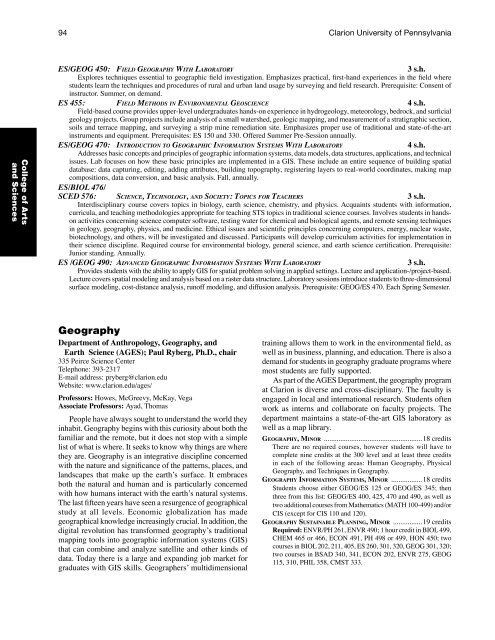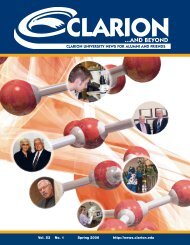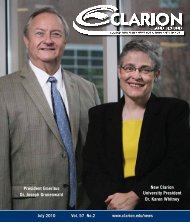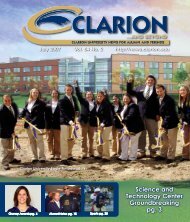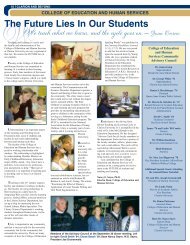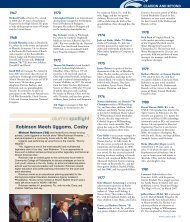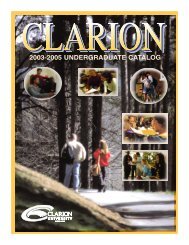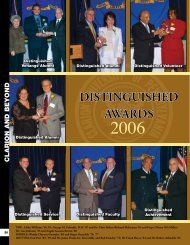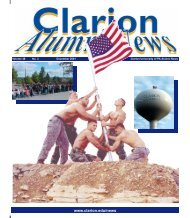Undergraduate - Clarion University
Undergraduate - Clarion University
Undergraduate - Clarion University
- No tags were found...
You also want an ePaper? Increase the reach of your titles
YUMPU automatically turns print PDFs into web optimized ePapers that Google loves.
pages i-viiiCollege of Artsand Sciences94 <strong>Clarion</strong> <strong>University</strong> of PennsylvaniaES/GEOG 450: Field Geography With Laboratory3 s.h.Explores techniques essential to geographic field investigation. Emphasizes practical, first-hand experiences in the field wherestudents learn the techniques and procedures of rural and urban land usage by surveying and field research. Prerequisite: Consent ofinstructor. Summer, on demand.ES 455: Field Methods in Environmental Geoscience 4 s.h.Field-based course provides upper-level undergraduates hands-on experience in hydrogeology, meteorology, bedrock, and surficialgeology projects. Group projects include analysis of a small watershed, geologic mapping, and measurement of a stratigraphic section,soils and terrace mapping, and surveying a strip mine remediation site. Emphasizes proper use of traditional and state-of-the-artinstruments and equipment. Prerequisites: ES 150 and 330. Offered Summer Pre-Session annually.ES/GEOG 470: Introduction to Geographic Information Systems With Laboratory4 s.h.Addresses basic concepts and principles of geographic information systems, data models, data structures, applications, and technicalissues. Lab focuses on how these basic principles are implemented in a GIS. These include an entire sequence of building spatialdatabase: data capturing, editing, adding attributes, building topography, registering layers to real-world coordinates, making mapcompositions, data conversion, and basic analysis. Fall, annually.ES/BIOL 476/SCED 576: Science, Technology, and Society: Topics for Teachers 3 s.h.Interdisciplinary course covers topics in biology, earth science, chemistry, and physics. Acquaints students with information,curricula, and teaching methodologies appropriate for teaching STS topics in traditional science courses. Involves students in handsonactivities concerning science computer software, testing water for chemical and biological agents, and remote sensing techniquesin geology, geography, physics, and medicine. Ethical issues and scientific principles concerning computers, energy, nuclear waste,biotechnology, and others, will be investigated and discussed. Participants will develop curriculum activities for implementation intheir science discipline. Required course for environmental biology, general science, and earth science certification. Prerequisite:Junior standing. Annually.ES /GEOG 490: Advanced Geographic Information Systems With Laboratory3 s.h.Provides students with the ability to apply GIS for spatial problem solving in applied settings. Lecture and application-/project-based.Lecture covers spatial modeling and analysis based on a raster data structure. Laboratory sessions introduce students to three-dimensionalsurface modeling, cost-distance analysis, runoff modeling, and diffusion analysis. Prerequisite: GEOG/ES 470. Each Spring Semester.GeographyDepartment of Anthropology, Geography, andEarth Science (AGES); Paul Ryberg, Ph.D., chair335 Peirce Science CenterTelephone: 393-2317E-mail address: pryberg@clarion.eduWebsite: www.clarion.edu/ages/Professors: Howes, McGreevy, McKay, VegaAssociate Professors: Ayad, ThomasPeople have always sought to understand the world theyinhabit. Geography begins with this curiosity about both thefamiliar and the remote, but it does not stop with a simplelist of what is where. It seeks to know why things are wherethey are. Geography is an integrative discipline concernedwith the nature and significance of the patterns, places, andlandscapes that make up the earth’s surface. It embracesboth the natural and human and is particularly concernedwith how humans interact with the earth’s natural systems.The last fifteen years have seen a resurgence of geographicalstudy at all levels. Economic globalization has madegeographical knowledge increasingly crucial. In addition, thedigital revolution has transformed geography’s traditionalmapping tools into geographic information systems (GIS)that can combine and analyze satellite and other kinds ofdata. Today there is a large and expanding job market forgraduates with GIS skills. Geographers’ multidimensionaltraining allows them to work in the environmental field, aswell as in business, planning, and education. There is also ademand for students in geography graduate programs wheremost students are fully supported.As part of the AGES Department, the geography programat <strong>Clarion</strong> is diverse and cross-disciplinary. The faculty isengaged in local and international research. Students oftenwork as interns and collaborate on faculty projects. Thedepartment maintains a state-of-the-art GIS laboratory aswell as a map library.Geography, Minor .......................................................18 creditsThere are no required courses, however students will have tocomplete nine credits at the 300 level and at least three creditsin each of the following areas: Human Geography, PhysicalGeography, and Techniques in Geography.Geography Information Systems, Minor ..................18 creditsStudents choose either GEOG/ES 125 or GEOG/ES 345; thenthree from this list: GEOG/ES 400, 425, 470 and 490, as well astwo additional courses from Mathematics (MATH 100-499) and/orCIS (except for CIS 110 and 120).Geography Sustainable Planning, Minor .................19 creditsRequired: ENVR/PH 261, ENVR 490; 1 hour credit in BIOL 499,CHEM 465 or 466, ECON 491, PH 498 or 499, HON 450; twocourses in BIOL 202, 211, 405, ES 260, 301, 320, GEOG 301, 320;two courses in BSAD 340, 341, ECON 202, ENVR 275, GEOG115, 310, PHIL 358, CMST 333.


